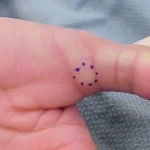Dry Eye Syndrome, also known as xerophthalmia, keratoconjunctivitis sicca, or simply dry eye, is the most common eye disease. It affects between 10% and 30% of the population, especially the elderly, and is characterized, as its name suggests, by causing a sensation of dryness in the eye, as well as pain, irritation, sensitivity to light, burning and even, in the most severe cases, alteration or loss of vision.
This means that patients’ quality of life is affected due to the negative impact of this pathology in numerous daily tasks such as reading, watching television, working with the computer, or driving.
The eyes are the organs of vision; They receive light signals from the environment and transmit them to the brain, creating images. In this process, the cornea and the tear film that covers it plays a fundamental role. Both structures are essential for focusing images and constitute the eye’s primary barrier to noxious stimuli.
The cornea is a clear “window” that covers the front of the eye. It is one of the most sensitive tissues in the body since it contains numerous nerve endings that detect and transmit information about the changes that occur on the ocular surface.
For its part, the tear film keeps the eyeball lubricated, allowing oxygen to be distributed to the surface cells, preventing infections, and ensuring correct light diffraction. The tear film comprises three layers:
- The innermost is the mucous layer.
- The middle layer is the watery one secreted by the lacrimal glands.
- The outermost layer is the oily layer, which prevents tear evaporation by maintaining the necessary moisture on the ocular surface.
For images to form quickly and focus, the tear film must be stable and evenly distributed over the ocular surface by blinking.
In patients with Dry Eye Syndrome, there are alterations in the composition and stability of the tear film. Sometimes these alterations are the consequence of tear secretion failures (deficiencies in the lacrimal glands or due to certain systemic diseases) or as a result of high evaporation of the aqueous component of tears (dry climates, poor closing of the eyelids, low frequency of blinking, alterations in the oil layer, use of contact lenses or even by the use of certain medications).
These situations threaten the stability of the tear film and produce poor or insufficient lubrication of the ocular surface, leading to ocular discomfort, pain, visual problems, inflammatory processes, and injuries.
If you suffer from any of the symptoms described above, go to an ophthalmologist for a personalized examination. At present, the treatment of Dry Eye Syndrome aims to alleviate its symptoms; for this, artificial tears are used that contribute to the lubrication of the eye and must be applied several times a day. Other treatments aside from tear substitutes include cyclosporine, tear duct occluders, or autologous serum.
What is Dry Eye Syndrome?
Dry eye syndrome is a multifactorial disease of the eye’s surface characterized by an alteration of the tear film that causes ocular discomfort and vision disturbances. This disease is accompanied by increased osmolarity (total concentration, measured as osmoles per liter, of a substance in a solution) of the tear film, ocular surface inflammation, and neurosensory alterations.
Mechanisms of disease
Dry eye syndrome is understood as a loss of the homeostatic mechanism (dynamic balance in the functions and composition of fluids and tissues) of the so-called Lacrimal Functional Unit (UFL). The UFL is made up of all the ocular surface components (conjunctiva, corneal epithelium, meibomian glands, and tear), the statics and dynamics of the eyelids, and the lacrimal glands, and the neural network (afferent pathway, efferent pathway – sympathetic and parasympathetic).
The UFL controls the main components of the tear film in a regulated way. It can be altered by external or environmental factors (low humidity, wind, working conditions, toxic), infections or trauma (including corneal surgery), as well as by internal factors such as inflammatory diseases that affect the supporting tissues, for alterations in the meibomian glands or the eyelid dynamics, due to alterations associated with innervation, either centrally or peripherally, or due to the adverse effects of drugs.
Its function is to preserve the peter little, the transparency of the cornea, and the quality of the image projected on the retina.
Tear film
The tear film is made up of water, fatty oils, and mucin that are divided into three layers:
The aqueous layer is the largest. It is made up of almost 100% water. Its function is to protect the eye from infections, lubricate it, clean it of small particles and provide oxygen and nutrients to the cornea.
The meibomian glands form the lipid layer that is the main source of lipids in the tear film and prevents the aqueous layer from evaporating. It acts as a lubricant between the eyelids and the cornea.
The mucous layer is the innermost and keeps the eye moist and lubricated by distributing the aqueous layer over the ocular surface.
The alteration of this UFL causes an unstable tear film that translates into hyperosmolarity of the tear (high concentration of tears with little fluid, either due to lack of tear production or increased evaporation) and inflammation of the ocular surface, which causes symptoms and signs of dry eyes.
The symptoms appear due to the hyperosmolarity that stimulates a cascade of inflammatory events in the superficial epithelial cells, which causes the death of these cells. Visual disturbances appear due to the irregularity of the tear film on the ocular surface. The signs (superficial punctate keratitis, filamentous keratitis, etc.) are secondary to the rubbing of the eyelids with the ocular surface.
Dry Eye Syndrome Classification
Cracked eye with a crossed-out drop, water-deficient dry eye.
Water-efficient dry eye. It occurs due to lack of tear production and is classified as:
Primary or secondary Sjögren’s syndrome. Primary Sjögren’s syndrome is a systemic disease characterized by autoimmune destruction of the exocrine glands throughout the body. The most affected organs are the eyes, the digestive system, the respiratory system, the skin, and the genitourinary system. It is diagnosed by the presence of dry eye combined with a dry mouth, certain antibodies, reduction in salivary secretion, and focal inflammation in a salivary gland biopsy. Secondary Sjögren’s syndrome has the same characteristics as primary Sjögren’s but is associated with the presence of another autoimmune disease such as rheumatoid arthritis, systemic lupus erythematosus, scleroderma, dermatomyositis, mixed connective tissue disease, and thyroiditis. Hashimoto’s, primary biliary cirrhosis, or chronic autoimmune hepatitis.

















Add Comment